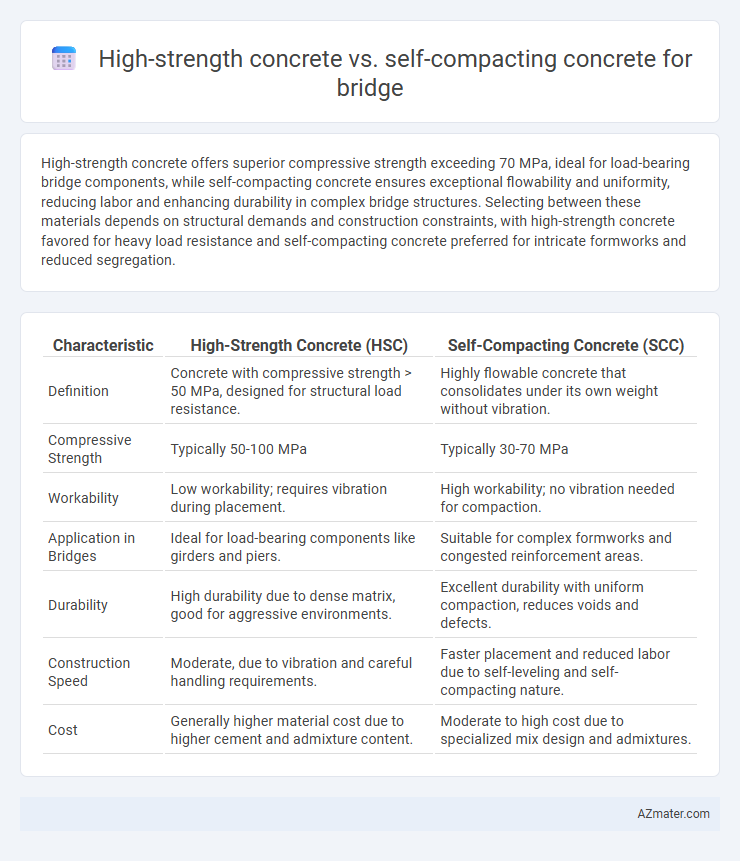High-strength concrete offers superior compressive strength exceeding 70 MPa, ideal for load-bearing bridge components, while self-compacting concrete ensures exceptional flowability and uniformity, reducing labor and enhancing durability in complex bridge structures. Selecting between these materials depends on structural demands and construction constraints, with high-strength concrete favored for heavy load resistance and self-compacting concrete preferred for intricate formworks and reduced segregation.
Table of Comparison
| Characteristic | High-Strength Concrete (HSC) | Self-Compacting Concrete (SCC) |
|---|---|---|
| Definition | Concrete with compressive strength > 50 MPa, designed for structural load resistance. | Highly flowable concrete that consolidates under its own weight without vibration. |
| Compressive Strength | Typically 50-100 MPa | Typically 30-70 MPa |
| Workability | Low workability; requires vibration during placement. | High workability; no vibration needed for compaction. |
| Application in Bridges | Ideal for load-bearing components like girders and piers. | Suitable for complex formworks and congested reinforcement areas. |
| Durability | High durability due to dense matrix, good for aggressive environments. | Excellent durability with uniform compaction, reduces voids and defects. |
| Construction Speed | Moderate, due to vibration and careful handling requirements. | Faster placement and reduced labor due to self-leveling and self-compacting nature. |
| Cost | Generally higher material cost due to higher cement and admixture content. | Moderate to high cost due to specialized mix design and admixtures. |
Introduction: Comparing High-Strength and Self-Compacting Concrete
High-strength concrete typically exhibits compressive strengths exceeding 6000 psi, making it ideal for bridge components requiring exceptional load-bearing capacity and durability under heavy traffic conditions. Self-compacting concrete, designed for high flowability without segregation, enhances the placement process in complex formworks and congested reinforcement, ensuring uniformity and reducing labor costs on bridge construction sites. Comparing these concretes highlights the trade-off between strength optimization and workability efficiency in modern bridge engineering applications.
Key Properties of High-Strength Concrete
High-strength concrete (HSC) for bridges is characterized by a compressive strength exceeding 6,000 psi, enhanced durability, and reduced permeability, making it ideal for structures subjected to heavy loads and harsh environmental conditions. Its low water-cement ratio and optimized aggregate gradation improve mechanical properties and long-term performance, ensuring resistance to cracking and corrosion. Compared to self-compacting concrete, HSC provides superior load-bearing capacity and structural integrity in critical bridge components such as piers and girders.
Core Characteristics of Self-Compacting Concrete
Self-compacting concrete (SCC) exhibits superior flowability, enabling it to fill complex bridge formworks without mechanical vibration, which reduces labor costs and improves structural integrity by minimizing voids. Its core characteristics include high deformability, segregation resistance, and exceptional homogeneity, ensuring uniform strength and durability in bridge applications. SCC's enhanced filling ability and stability make it a preferred material over traditional high-strength concrete for complex geometries and congested reinforcement in modern bridge construction.
Mechanical Performance: Strength and Durability
High-strength concrete exhibits superior compressive strength, often exceeding 70 MPa, making it ideal for load-bearing bridge components requiring enhanced durability under heavy traffic and environmental stress. Self-compacting concrete, characterized by its high flowability and homogeneity, offers consistent mechanical performance with strengths typically ranging from 40 to 70 MPa, facilitating complex formwork filling and reducing voids that could compromise long-term durability. Both concretes contribute to bridge longevity; however, high-strength concrete excels in ultimate strength capacity, while self-compacting concrete enhances structural integrity through improved material distribution and reduced defects.
Workability and Placement Techniques
High-strength concrete (HSC) offers superior compressive strength but often requires advanced formwork and mechanical vibration for placement due to its low workability. Self-compacting concrete (SCC) provides excellent flowability and can fill complex bridge forms without vibration, reducing labor and minimizing defects. Optimization of placement techniques depends on the balance between HSC's strength benefits and SCC's efficient workability in bridge construction projects.
Construction Speed and Efficiency
High-strength concrete offers exceptional load-bearing capacity, making it ideal for structurally demanding bridge components, but its placement often requires vibration and careful curing, potentially slowing construction speed. Self-compacting concrete flows effortlessly into complex formworks without vibration, significantly enhancing construction speed and efficiency, especially in intricate bridge geometries and congested reinforcement. Choosing between the two depends on project priorities, with high-strength concrete focusing on structural performance and self-compacting concrete optimizing rapid, labor-efficient placement.
Cost Implications and Material Usage
High-strength concrete reduces material volume and structural element size, potentially lowering overall construction costs despite higher cement content and admixture expenses. Self-compacting concrete minimizes labor and equipment costs through enhanced workability and faster placement, though it requires more fine materials and chemical additives, increasing per cubic meter price. Choosing between the two depends on project scale, labor availability, and budget constraints related to material procurement and placement efficiency in bridge construction.
Applications in Modern Bridge Projects
High-strength concrete is widely used in modern bridge projects for its superior load-bearing capacity and durability, enabling longer spans and reduced structural thickness. Self-compacting concrete facilitates complex formwork and densely reinforced sections without mechanical vibration, improving construction speed and surface finish quality. Both types enhance bridge performance, with high-strength concrete preferred for critical structural elements and self-compacting concrete favored in intricate or congested areas.
Sustainability and Environmental Impact
High-strength concrete reduces the amount of material needed for bridge structures, lowering resource consumption and associated carbon emissions. Self-compacting concrete enhances sustainability by minimizing the need for mechanical vibration, reducing noise pollution and energy use on-site. Both types contribute to durable bridges with extended lifespans, decreasing lifecycle environmental impacts through reduced maintenance and material replacement.
Selection Criteria: Which Concrete for Your Bridge?
High-strength concrete offers superior compressive strength and durability, making it ideal for bridges requiring high load capacity and long-span performance. Self-compacting concrete enhances workability and reduces labor costs with its ability to flow and fill intricate formwork without vibration, suitable for complex or congested reinforcement. Selection depends on structural demands, construction conditions, and project budget, with high-strength concrete favored for heavy load-bearing and self-compacting concrete preferred for ease of placement in challenging environments.

Infographic: High-strength concrete vs Self-compacting concrete for Bridge
 azmater.com
azmater.com